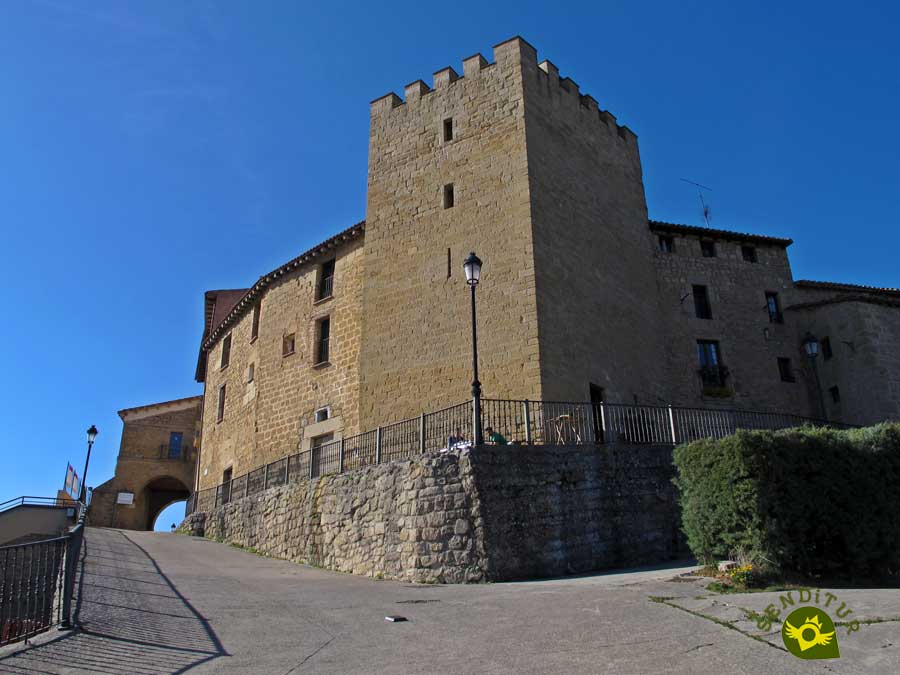It is located on a hill, between the Labraza and Valdevarón streams, protected by the Cantabria and Codes mountain ranges, in the foothills of the Cantabria mountain range to the south of the province of Álava, and has been part of the municipality of Oyón since 1977, within the Cuadrilla Laguardia-Rioja Alavesa. Although its historical roots are submerged in Prehistory, Labraza was founded as a defensive village by Sancho VII, who also granted it privileges in 1196, over what was only a village known as Villa de Labraça, which from then on became known as San Cristóbal de Labraza.

The town, which had an important presence in medieval struggles, belonged to the kingdom of Navarre until 1461 when it was conquered by the troops of Pedro Girón for the Castilian kingdom and it was not until 1501 when it became part of the Brotherhoods of Alava. Labraza in the sixteenth century was ruled by an ordinary mayor, a procurator general, a deputy of the common ... there are still between his hamlet the houses called the governor and bishop. Felipe II, at the end of the same century, granted him the privilege of not being able to be alienated from the crown, a concession that was later ratified by Felipe III in 1601 and by Felipe IV in 1622. The current town of Barribousto depended on Labraza until it became independent in the 19th century. Its main economic activity, agriculture and livestock, reflected in the jurisdiction, has practically lasted to the present day.

Accessing the beautiful medieval town of Labraza through the Main Gate or Door of La Concepción which, located in the centre of the southern wall, preserves in the inner arch the channels through which the closing rake ran, is like crossing a time gate which takes the visitor back to the perhaps most flowering stage of Labraza, the medieval stage. Walking along one of the three streets that make up the town, the street of La Concepción leads to the square in which is the church of San Miguel from the sixteenth century whose Gothic style walls formed part of the wall. Of the perimeter that the walls had, only the tower and the layout of the south and west canvases are preserved. There are no remains of the castle, of which there is documentation.

Between its streets, the streets of La Concepción, San Miguel and San Roque, you can see passageways, alleys, and houses that, built mostly in stone and dating from the sixteenth and seventeenth centuries, have semicircular arcades and many of them have been attached to the wall itself. The Fountain of the Moor, excavated in the south slope of the wall, is of century XIV and receives the name by the decoration that shines the spout of its interior, a Gothic face. Places and corners, all with their art and history, which make up this idyllic village of Labraza in whose surroundings you can enjoy entertaining hiking trails that will make us enjoy an exuberant nature, not in vain Pinar de Dueñas, near Labraza, is the forest of Aleppo pine more western Europa.

Labraza celebrates its patron saint San Miguel on the 29th of September while the summer festivities are the first or second weekend of August.
The theatrical visits, on Sundays in September and October, make the visitor enjoy and travel through part of the history of this charming enclave that was worthy, in 2008, of the World Prize of Walled Cities, an award that is granted every three years by the prestigious Executive Council of the International Circle of Walled Cities. In order to be able to go to the representations it is necessary to do previous reservation in the Office of Tourism of Laguardia or in the telephone 945 600 845. In Labraza also persists the tradition that three days a year, by San Roque, San Miguel and Purísima, the neighbors invite to a tasting of pinchos.
It is believed that Pio Baroja was inspired by Labraza and its surroundings when he wrote El Mayorazgo de Labraza, one of the novels that form, together with Zalacaín el aventurero, La casa de Aitzgorri and La leyenda de Jaun de Alzate, the tetralogy Tierra vasca.

Popular history tells us that from the Fountain of the Moor, excavated in the south slope of the wall in the 14th century, a secret passage departed towards the interior of the town that guaranteed the provision of water when they suffered some siege.
MORE ROUTES AVAILABLE, DON'T MISS IT...
MORE PLACES AVAILABLE, DON'T MISS IT...
Labraza can be reached from Vitoria-Gasteiz via the port of Bernedo and from Logroño, towards Oion on the A-2126 and after passing Moreda, you will reach the fortified town where traffic is forbidden and there will be parking facilities.
Labraza has a stop for the regular bus service that covers the Logroño-Oyón-Laguardia route on a daily basis.
SENDITUR is not responsible for any variation in the information described, as well as for the misuse of its guides and recommends that everyone be responsible and prudent in carrying out the activity. Likewise, we invite you to document yourself with books and specialized guides to complement the information described. From the commitment of SENDITUR with Nature and the respect to the balance of the environment, SENDITUR urges you to travel in a responsible way, with low environmental impact and respecting at all times the Natural, Cultural and Social environment wherever you go. For any suggestion, SENDITUR invites you to send an email to .
Continue watching …